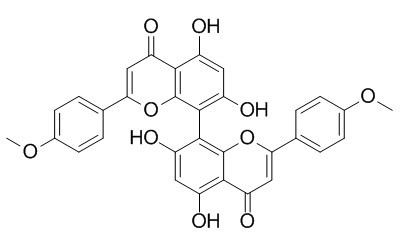4',4'''-Di-O-methylcupressuflavone
4',4'''-Di-O-methylcupressuflavone is a natural product from Phyllanthus niruri Linn.
Inquire / Order:
manager@chemfaces.com
Technical Inquiries:
service@chemfaces.com
Tel:
+86-27-84237783
Fax:
+86-27-84254680
Address:
1 Building, No. 83, CheCheng Rd., Wuhan Economic and Technological Development Zone, Wuhan, Hubei 430056, PRC
Providing storage is as stated on the product vial and the vial is kept tightly sealed, the product can be stored for up to
24 months(2-8C).
Wherever possible, you should prepare and use solutions on the same day. However, if you need to make up stock solutions in advance, we recommend that you store the solution as aliquots in tightly sealed vials at -20C. Generally, these will be useable for up to two weeks. Before use, and prior to opening the vial we recommend that you allow your product to equilibrate to room temperature for at least 1 hour.
Need more advice on solubility, usage and handling? Please email to: service@chemfaces.com
The packaging of the product may have turned upside down during transportation, resulting in the natural compounds adhering to the neck or cap of the vial. take the vial out of its packaging and gently shake to let the compounds fall to the bottom of the vial. for liquid products, centrifuge at 200-500 RPM to gather the liquid at the bottom of the vial. try to avoid loss or contamination during handling.
Molecules.2020, 25(21):5087.
Food Chemistry: X2023, 101032.
J Adv Res.2019, 17:85-94
Research on Crops.2017, 18(3):569
In Vitro Cellular & Developmental Biology - Plant 2021, 57:874ĘC882.
Chulalongkorn University2024, ssrn.4716057.
Korean J Acupunct2020, 37:104-121
Antioxidants (Basel).2020, 9(4):284.
J-STAGE2015, 249-255
Front Pharmacol.2019, 10:1025
Related and Featured Products
Planta Med. 1995 Aug;61(4):391.
A Triterpene and Phenolic Compounds from Leaves and Stems of Phyllanthus sellowianus[Reference:
WebLink]
The plants of the genus Phyllanthus (Euphorbiaceae) have been popularly employed for the treatment of kidney and bladder calculi, diabetes, hepatitis, and dysentery, and have also been used against affections of the intestines (1, 2).
METHODS AND RESULTS:
Previous studiescarried out by our laboratory have demonstrated that some alkaloids isolated from P. sellowianus exhibited an antispasmodic activity similar to papaverine in several pharmacological models (3). One of the compounds was identified as a new alkaloid denoted as phyllanthimide (4). Recently, we have also shown that the hydroalcoholic extracts of several species of the genus Phyllanthus, including P. sellowianus, given either orally or intraperitoneally, exhibited potent antinociceptive activity in different models of nociception in mice (5). Recent papers on the chemistry of this species have shown the presence of a sterol, phyllanthol (6), a biflavonoid, 4',4'''-Di-O-methylcupressuflavone (7), a mixture of sterols containing stigmasterol, beta-sitosterol,and campesterol, as well as an acetophenone, 2-hydroxy-4,6-dimethoxyacetophe-none (xanthoxyline) (8).
CONCLUSIONS:
In this study, we describe the isolation and identification of other compounds, not reported, as far as we know, for P. sellowianus.



